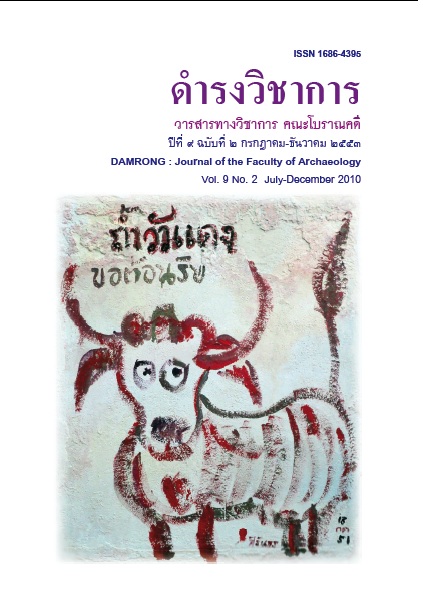A REFLEXION ON MURAL PAINTINGS OF THE 24th – 25th BUDDHIST ERAS AROUND THE SAKAKRANG RIVER SOCIETY, AMPHOE MUEANG, UTHAI THANI PROVINCE
Keywords:
ศิลปกรรม, จิตรกรรมฝาผนัง, ลุ่มแม่น้ำสะแกกรังAbstract
This research covers five temples located in Amphoe Muang, Uthai Thanee province, where mural paintings were discovered: Ubo-satharam temple, Pichai-puranaram temple, Thamma-khosok temple, Ammarit-thavaree temple and Mai-chantharam temple. The temples were built around the 24th - 25th Buddhist era, and each temple has its own unique character and story.
During the 24th - 25th Buddhist eras, several races, including Chinese, Laos, Karieng and local people, had already immigrated and settled around Sakaekrang river. Each ethnic group influenced the style of the mural paintings, representing the state of society at that period in time.
From this study, we can see fine examples of the Laos influence upon mural paintings on the outside wall of Ubo-satharam temple. The mural paintings were influenced by the Northeastern people of Thailand, judging from the natural scenes depicted on the paintings; specifically, chapters about Vessantara Jataka which are painted inside the building. In addition, Laotian local people are clearly recognizable depicted in the painting visible when entering Mahaniravana—of the Lord Buddha’s life, which has never been found anywhere else.
The social revolution during the reigns of King Rama IV and King Rama V introduced new painting themes, for instance: the story depiction of worship of Buddha's footprint, at Saraburee province, which is about traditional culture; the ten Asupa-kammathan images, which represent the monk’s duties; the Chantakolop folktale story depiction. Even though, the new painting themes were fully developed, it can be interpreted that the local people still maintained their original beliefs in supernatural miracles such as the story of the Malai monk.
All of these mural paintings at the five temples provide tremendous opportunities for study by future generations, especially areas such as: characteristics, painting techniques, lifestyle, the costume styles of the people around Sakaekrang River and the social revolution during the reigns of King Rama IV and King Rama V which include images of motorboats, steamships and the rice mill chimneys.
References
ไพโรจน์ สโมสร, จิตรกรรมฝาผนังอีสาน, (ขอนแก่น: ศูนย์วัฒนธรรมอีสาน มหาวิทยาลัยขอนแก่น, 2532), 123.
สมชาย นิลอาธิ, “ข้อสังเกตเกี่ยวกับจิตรกรรมสิมอีสาน,” ศิลปวัฒนธรรม 4, 5 (มีนาคม 2526): 87.
จิราพร ปิ่นสุวรรณบุตร, “การศึกษาภาพจิตรกรรมฝาผนังวิหาร วัดอุโบสถาราม ความสัมพันธ์กับชาวลาวในท้องถิ่น จังหวัดอุทัยธานี,” สารนิพนธ์ศิลปศาสตรบัณฑิต สาขาวิชาประวัติศาสตร์ศิลปะ คณะโบราณคดีมหาวิทยาลัยศิลปากร, 2546, 31. อ้างจากเสรี ตันศรีสวัสดิ์, สะบายดีหลวงพระบาง (กรุงเทพมหานคร: ธาร บัวแก้ว, 2544), 58.
ภัทรพงษ์ เก่าเงิน, “จิตรกรรมฝาผนังวัดหน่อพุทธางกูร: การผสมผสานกันอย่างลงตัวของศิลปะ ไทย จีน และลาว,” 48-55.
สัมภาษณ์ สีนิน จันทรักษ์, ผู้ที่ทอผ้าพื้นเมือง และเป็นชาวลาวครั่งที่อาศัยอยู่ในอําเภอบ้านไร่ จังหวัดอุทัยธานี, 25 กุมภาพันธ์ 2553.
สมเด็จฯ กรมพระยาดํารงราชานุภาพ ทรงอธิบายว่า ลาวพุงขาวคือลาวชาวมณฑลอุดร และอีสาน ส่วนลาว พุงดํา คือ ลาวแถบมณฑลพายัพ อ้างจาก ศิริพันธ์ ตาบเพ็ชร, “ฮูปแต้มสิมอีสาน จังหวัดมหาสารคาม,” เมือง โบราณ 24, 4 (ตุลาคม – ธันวาคม 2541): 79.
ประภาศรี พงษ์ดํา, วัฒนธรรมประเพณีพื้นบ้านในจิตรกรรมฝาผนัง (กรุงเทพมหานคร: สํานัก โบราณคดี และพิพิธภัณฑสถานแห่งชาติ กรมศิลปากร, 2539), 99.
เด่นดาว ศิลปานนท์, พระมาลัยในศิลปกรรมไทย (กรุงเทพมหานคร: กรมศิลปากร, 2547), 12.
พลาดิศัย สิทธิธัญกิจ, มรดกใหม่จากลุ่มน้ำสะแกกรัง (กรุงเทพมหานคร: ต้นอ้อ, 2534), 91.
จิราพร ปิ่นสุวรรณบุตร, “การศึกษาภาพจิตรกรรมฝาผนังวิหาร วัดอุโบสถาราม ความสัมพันธ์กับชาวลาวในท้องถิ่น จังหวัดอุทัยธานี,” 19.
ปาริสุทธิ์ สาริกะวณิช, การศึกษาบทบาทของจิตรกรรมฝาผนัง ประเภท ภาพกากในเขตอําเภอโพธาราม จังหวัดราชบุรีในฐานะเป็นภาพสะท้อนสังคม และวัฒนธรรม (ปทุมธานี: มหาวิทยาลัยรังสิต, 2541), 19.
จดหมายเหตุรัชกาลที่ 3 จ.ศ.1206 (พ.ศ.2387) ร่างตราเรื่องได้รับใบบอกรายชื่อแม่กองทําศิลาเขาชะโชก. เลขที่ 149 มัดที่ 55. อ้างจาก ศักดิ์ชัย สายสิงห์, “ศูนย์กลางจักรวาลกับสถาปัตยกรรม วัดสุทัศนเทพวราราม,” ในงานวันพระบาทสมเด็จพระนั่งเกล้าเจ้าอยู่หัว ประจําปี 2552 "พระนั่งเกล้าฯกับความเป็นศูนย์กลางจักรวาลของวัดสุทัศน์ฯ” (กรุงเทพมหานคร: ฝ่ายศิลปวัฒนธรรม มหาวิทยาลัยศิลปากร, 2552), 56.
สัมภาษณ์ ศิริ พจน์ เหล่ามานะเจริญ, อาจารย์ประจําภาควิชาประวัติศาสตร์ศิลปะ คณะโบราณคดี มหาวิทยาลัยศิลปากร, 16 กุมภาพันธ์ 2553.
ชมพูนุท ประศาสน์เศรษฐ, “เทคนิคและวัสดุของจิตรกรรมฝาผนังไทยแบบดั้งเดิม,” เมืองโบราณ 24, 4 (ตุลาคม-ธันวาคม 2541): 97.
สัมภาษณ์ สมบุญ พุ่มสกุล, พนักงานในพิพิธภัณฑสถานแห่งชาติสมเด็จพระนารายณ์, 2 กุมภาพันธ์ 2553.
Downloads
Issue
Section
License
บทความนี้เป็นผลงานของข้าพเจ้าแต่เพียงผู้เดียว และ/หรือเป็นผลงานของข้าพเจ้าและผู้ร่วมงาน ตามชื่อที่ระบุในบทความจริง และเป็นผลงานที่มิได้ถูกนำเสนอหรือตีพิมพ์ที่ใดมาก่อน


